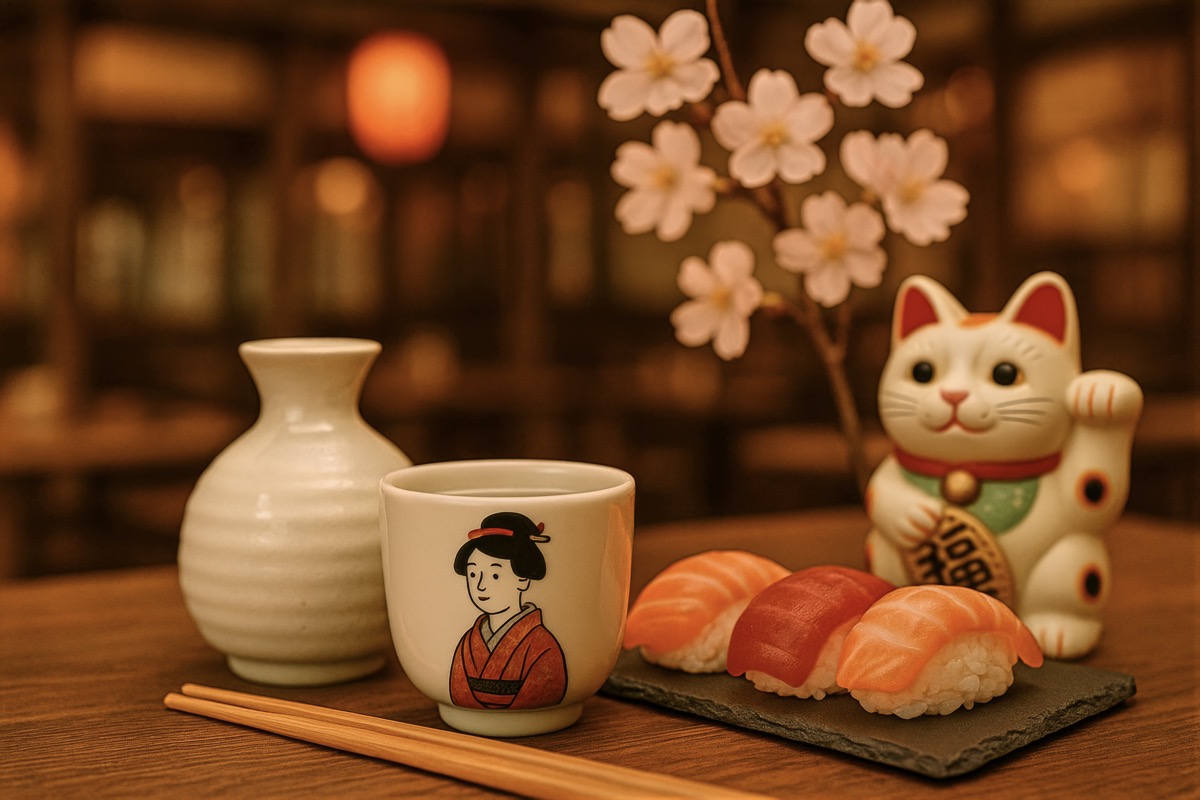Heritage in a Glass
The Day Sake Entered UNESCO’s Roll of Honor
On December 5, 2024, Japan’s centuries-old craft of brewing sake with rice, water, and the transformative power of kōji mold was inscribed on UNESCO’s Intangible Cultural Heritage list. A decade earlier, washoku, the cuisine itself, received the honor. Then, the dishes were the stars. This time, the spotlight falls on the drink that completes the table.
The pairing of these two honors says a great deal. With food acknowledged in 2013 and sake in 2024, Japan’s culinary culture is now recognized in full. That small cup beside a lacquered tray is no longer a mere accessory. Cuisine and sake together form a single cultural whole, two halves of one expression.
From Fast-Food Exotic to Everyday Choice
France may have felt this shift more than anywhere. In the early 2000s, Paris’s Rue Sainte-Anne, tucked behind the Opéra, drew lines of diners for sushi and ramen, the quick, exotic image of Japan.
As young chefs began introducing the subtleties of dashi and fermentation, the picture changed. By the time UNESCO honored washoku, Japanese food had already become part of daily life in Paris.
The Turning Point for Sake
Sake lagged behind. In the French imagination, it was lukewarm, poured in teacups, and hard to describe in the language of wine.
That began to change in 2017 with the launch of Kura Master, a Paris-based competition where sommeliers tasted sake in wine glasses and described its flavors with a familiar vocabulary of acidity, aroma, and finish.
For the first time, sake could be explained to the French palate.
Festivals, Local Rice, Local Water
That same year, the Salon du Saké started drawing thousands each autumn. Today, with more than five thousand visitors, it is a fixture on the Paris food calendar.
In 2019, the opening of WAKAZE near Paris, brewing sake from French-grown rice and local water, marked another step forward. Sake was no longer only an import. It was being crafted here and shaped by a new terroir.
How the French Choose Their Sake
In a Japanese liquor shop, customers rarely quiz the clerk about the exact rice variety or polishing ratio. In France, those questions come naturally.
Buying sake here works very much like buying wine. You tell the shopkeeper what you plan to serve, describe your preferences for aroma and flavor, and expect an informed recommendation. Price is only one part of the decision.
French drinkers consider the rice variety and the brewing method, comparable to grape varietals in wine, the provenance and history of the brewery, the flavor profile, whether dry or sweet, aromatic or restrained, and how the sake will interact with the food on the table.
In other words, sake is chosen as part of a larger dining story, not as a stand-alone drink. For producers and exporters, bringing sake to France requires more than shipping bottles. It is about delivering a narrative and an experience that connects the drinker not only to the liquid in the glass but also to the place, the people, and the craft behind it.
Rediscovering Sake in Paris From Misunderstanding to Authenticity
Today in France, it is no longer unusual to find a boutique devoted entirely to sake, or a wine shop where elegant bottles of daiginjō and junmai ginjō stand alongside Burgundy and Bordeaux.
Stroll through Paris and you may catch sight of them in a shop window, sleek glass bottles with minimalist labels, their contents as clear and refined as the wines they share the stage with.
This transformation is recent. Not long ago, anyone in Paris seeking sake had little choice but to visit an Asian grocery store. Shelves might have held a few bottles, yet staff were rarely versed in the nuances of sake.
Questions such as “What does this pair with,” “What is the difference between ginjō and daiginjō,” or “Which one is easiest to drink” often met with polite shrugs.
For many Parisians, sake remained an enigma, mysterious, hard to navigate, and easy to avoid.
A Case of Mistaken Identity
Part of the problem lay in a long-standing misconception. Until the early 2000s, many inexpensive “Japanese” restaurants in Paris, often run by non-Japanese Asian owners, offered diners a complimentary glass of “sake” at the end of the meal.
More often, it was Chinese baijiu, a high-proof distilled liquor made from rice or sorghum, or a sweet, flavored spirit with added sugar and artificial aromatics. At around forty percent alcohol, the aroma was bracing and the burn immediate. That is a world apart from the delicate balance of umami and gentle rice sweetness that defines true sake.
For countless Parisians, this was their first, and sometimes only, experience of “Japanese sake.” The result was a persistent, misleading impression that sake was a fiery digestif taken as a shot after dinner, not a companion to food.
For those who had never tasted the real thing, a first sip of this ersatz version was enough to fix the idea. It left little room for the subtlety, softness, and layered aromatics of genuine sake to be discovered, and it quietly eroded sake’s potential prestige in France for years.
*Note. This does not mean Chinese baijiu is inferior. There are many kinds of baijiu, including very expensive high-end bottles of superb quality. It is simply a different spirit from sake, with a different method of production and a different way of being enjoyed.
The Effort to Bring True Sake to the French Table
For decades, what passed for “sake” in France was a misunderstanding that stuck. Sake was seen as exotic, potent, and ill-suited to the table.
That caricature began to fade in the late 1990s as sushi quietly embedded itself in urban life. Raw fish was no longer shocking. It was chic. With sushi came curiosity, and curiosity opened the door to the real drink that had been absent. Importers and Japanese breweries looked beyond Tokyo and Kyoto and found in Paris a stage eager for novelty yet grounded in tradition.
The turning point came in 2013 with the launch of the Salon du Saké, an annual gathering in Paris that offered French sommeliers and chefs a serious immersion in Japan’s brewing culture. There, sake was not an afterthought. It was the lead, poured and discussed with the reverence usually reserved for Burgundy. Figures such as sommelier Xavier Thuizat championed its subtlety, framing it not as a curiosity but as a partner to gastronomy.
French chefs, always alert to texture and nuance, embraced it. In Michelin-starred kitchens, sake began to appear beside foie gras, sole meunière, and even desserts. The vocabulary of wine, ideas of terroir, minerality, and vintage, slipped into conversations about rice and water. Some breweries leaned into the parallel with sparkling sake inspired by Champagne. Others drew on the French idea of terroir to articulate regional identities that had long been implicit in Japan.
Today, walking into a Paris boutique devoted entirely to sake is no longer unusual. Bottles stand in line like grand crus, labels in kanji and rōmaji, provenance explained with the same precision as a Chablis. Japan has formally petitioned UNESCO to recognize traditional sake brewing as intangible cultural heritage, a reminder that what once seemed foreign and misunderstood is now seen as a cultural treasure.
Sake’s arrival in France has been less an invasion than a revelation. No longer dismissed as a curiosity, it has become a mirror, reflecting Japan’s centuries of craft and France’s openness to reinterpret tradition at the table.
Exploring the Depth of Japanese Sake in Paris Inside the Salon du Saké
Every autumn in Paris, a corner of the city turns into a gateway to Japan’s drinking culture.
The Salon du Saké, Europe’s largest celebration of sake and related beverages, brings together sake breweries along with shōchū, umeshu, green tea, wagashi, traditional crafts, and even travel experiences.
For three days, the event becomes a living showcase of Japan’s flavors and traditions in one place.
Beyond Tasting A Place to Learn
The Salon is not only about sipping. It is also about understanding. Throughout the weekend, visitors can join talks by sommeliers, sake specialists, and master brewers.
Masterclasses and workshops, often free but sometimes requiring advance booking, explore regional styles, brewing techniques, and food pairings. Paid tasting sessions offer rarities such as wagashi and sake pairings, a delicate cross-cultural dialogue on the palate.
Salon du Saké 2025 Dates and Details
The 2025 edition runs from Saturday, October 4, to Monday, October 6, at the New Cap Event Center along the Seine in the fifteenth arrondissement. More than fifteen hundred square meters of exhibition space will host breweries from across Japan, importers, and producers from around the world, with over six hundred varieties of sake and related products.
Last year drew roughly six thousand visitors and between fifty and sixty exhibitors, many from France but also from Japan, the rest of Europe, and beyond. It is further proof that sake is no longer a niche curiosity but an established presence in the European drinks scene.
Admission & Tickets
General public. Saturday and Sunday only.
-
1-day pass: €25
-
2-day pass: €40
Tickets are available online or at the venue.
Trade professionals. Monday only, free with proof of profession such as a business card or certification.
Where to Buy Sake in Paris
In recent years, Paris has quietly built a network of specialty shops and concept stores dedicated to sake. Locals and visitors alike now take bottles home for casual dinners or elaborate pairings. Here are four standout addresses, each offering its own lens on sake culture.
I like Japanese restaurants abroad. Any country, any town. If the owner is Japanese, you can feel how that country holds his Japan. Postcards on the wall and a beer poster with softened corners keep the years he has lived through. If the owner is not Japanese, it is interesting in a different way. Curiosity arrives on a plate. They cook the Japan they carry in their heads. Sometimes it lands and you nod. Sometimes it misses and finds something new, and you keep eating anyway because it is good in its own way.
In grand cities like London or Paris, I often felt you could order a Japanese restaurant starter kit from a catalog. You open the box and there it is. One beckoning cat with a cheerful wrist that never tires. A string of silk cherry blossoms that will never wilt. A beer poster with a smiling woman in a kimono. The same glossy photo menu. A stack of plastic bowls that could survive a war.
I have always wondered why non-Japanese owners name their places after prefectures. Maybe that was part of the kit. Tokyo, Osaka, Kyoto of course, but also Hokkaido, Nagano, Shizuoka, even Akita. I wonder what made him choose that prefecture. A friend once said, maybe he closed his eyes, pointed at a map of Japan, and that prefecture was it.
My first sushi in Paris knocked me back. In Japan the rice is seasoned with vinegar. Here people seemed spooked by sour rice, so the vinegar was gone. A thick slab of raw fish sat on a plain ball of rice. The miso soup told the same story. No dashi, no broth from kelp and bonito, only miso paste and mushrooms drifting in hot water. Yakitori came with a seam of cheese. The soy sauce was sugared. You could search the whole tray and not find the taste of home.
There was a place near my office called Hokkaido, and it fit that mold. On days when we wanted something simple, something lighter than pizza, we drifted there for lunch and sometimes for dinner. We did not go for flavor. The sushi and the yakitori were always slightly off, a little missing here, a little extra there. No one commented on the taste. Everyone wore the look of people who believe Japanese food is good for your health, so they would endure the rest.
The meal ended with a small ceremony, a complimentary thimble of “sake.” My French colleague always said, you know the saying, good medicine is bitter. This shot of sake is for digestion. Come on, bottoms up. As the lone Japanese person at the table, I could not let it pass. That is not sake, I said. Real sake has the measured strength of wine. It is not a post-meal tonic. It is meant to be savored alongside the food. My colleagues had never tried proper sake and did not plan to. They would nod, offer a polite huh, reach for their coats, and we would go back to work.
Meanwhile, Japanese cuisine in Paris kept evolving in quiet steps. Chefs worked with unshowy integrity. They chose French produce with care and turned it into food that was as beautiful as it was precise. Their dishes could surprise people already smitten with washoku back in Japan and the curious first-timer. One plate at a time, they won a cadre of French regulars. Soon the city filled with the real thing, sushi counters devoted to nothing else, true kushiage specialists, marquee ramen houses from Japan opening outposts, and bars that served only gyoza, which quickly took root.
The shift picked up speed in October 2006 when a small Franco-Japanese group, the privately run Committee for the Promotion of Japanese Restaurants, created a recommendation system to signal what counted as authentic. On January 16, 2007 they named fifty restaurants and issued a discreet seal for the door. The Japanese Embassy in Paris joined as an observer and helped push a guide through the consulates so diners could tell before they sat down.
Paris now had the bones of a real Japanese dining culture. The finishing touch was the drink, sake. In the next chapter we will trace how it moved from curiosity to credential, and how it won the trust of Michelin-starred chefs..



